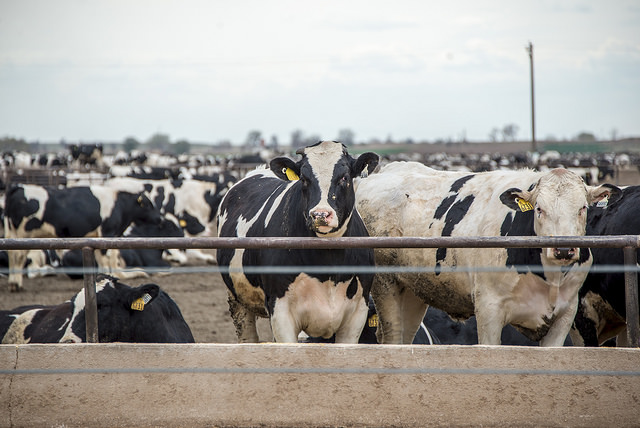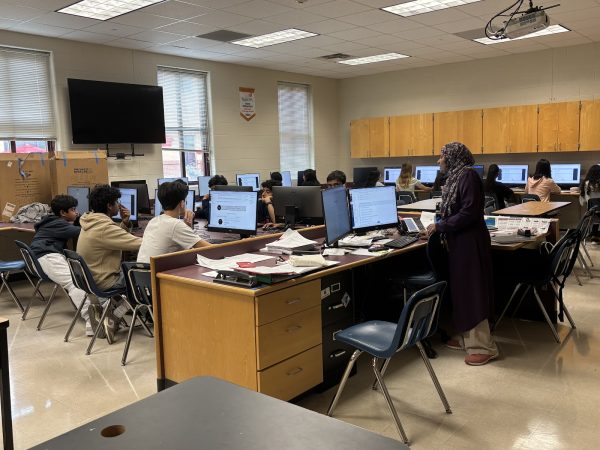How corporate farming is taking the “agri” out of agriculture- and what one can do to stop it
Taken on March 3rd 2016, some rights reserved, (http://bit.ly/1ryPA8o),no changes were made, original work (https://flic.kr/p/DEDUCC)
As the world is becoming more industrialized, so is agriculture. Corporations such as Tyson have been developing more effective measures to produce larger amounts of meat more quickly. However, these more “effective” methods may have the benefit of greater production, but what is the cost?
Chickens find themselves tossed to the ground and fattened until they are unable to stand. Their bodies are unable to keep up with the growth resulting from their diets. They can’t go outside to walk, and have barely any area to move, with approximately 10,000 in one house. It’s common for chickens to die due to being trampled by others. Even some “free-range” chickens are subjected to this, but given a bit more room to move around. Most chickens die without even seeing sunlight. Companies that encourage this behavior, such as Tyson, refuse to speak on this and disallow their farmers to speak about it.
As for cows, they are usually raised on a pasture until they are about a year old. Then, they get moved to a feedlot, are forced to live in suffocating conditions, and then are shipped off to a factory once they are acceptably fattened. At these feedlots, they are highly susceptible to an antibiotic-resistant strain of E Coli., which the proven presence of has not shut down plants. Cow manure piles up and is moved to other grounds, often polluting the surrounding environment and exposing it to unusual bacteria. On feedlots, Suzanne McDowell Geddes, owner of the Cumming Harvest, says, “They are bad for the animals, bad for the environment and bad for us. I believe cows should be raised in a pastured environment, free to roam and eat healthy grass. Unhealthy cows means more room for unhealthy meat.” The corn they are fed causes irregularities in their digestive systems, as they are naturally equipped to eat grass; however, since corn is easy to mass-produce, it is used as an alternative to grass.
Corn is found in nearly every item at a supermarket, from soda, to candy, to breads. It has many uses, and can be refined into syrups, like high fructose corn syrup. This demand for corn products causes farmers to stretch the limits of the land, with farms often spanning miles. Growing solely corn causes a monoculture- the cultivation of a single crop in a given area -which has resulted in agricultural disruptions and was the primary cause of the Dust Bowl. The artificial fertilizers and toxic pesticides and herbicides are poisoning the earth and seeping into waterways.
Plants and livestock are not the only ones suffering, however. Farmers are trapped into contracts with large companies, wherein they must pay for all of the equipment and their earnings go towards paying it off- but, just one chicken house and it’s necessary equipment can cost upwards of $1 million dollars, and it has to be replaced as new technologies are developed, though farmers make an average of $94 thousand, without taking account of taxes, production costs, and employee payment. They aren’t permitted to sell their crops for profit except to the companies they are working for. Migrant workers are exploited further, being excluded from forming trade unions, bargaining collectively, and often face illegal activity by their employers, but will lose their only source of income if they are fired. A Huffington Post article, Farm Workers Walk Fine Line Between Exploitation and Forced Labor, states, “Globally, agriculture is one of the high-risk sectors into which workers are trafficked for the purpose of forced labor. According to the International Labor Organization’s most recent estimate, illicit profits generated by forced labor amount to $150 billion per year, of which an estimated $9 billion is made in agriculture.”
So, in order to circumvent supporting the practices of corporate farming, what should one do? Local, organic, sustainable foods are more expensive, which causes many to be unable to purchase them. This is largely due to the fact that there is a lack of government subsidizing for such farming practices, but that’s unlikely to change. As such, the best alternative is to grow as much of your own food as possible to cut down on food costs, while purchasing sustainable goods as often as possible. Even in small spaces, it’s possible to at least grow one type of food. If you have a roof, rooftop gardening can be incredibly effective, for one’s family and the community, as seen in the case of Kiado Cruz of Oaxaca, Mexico. Vertical gardening, rooftop gardens, and outdoor gardens are useful in most spaces, and you can grow a variety of herbs and small produce, depending on how much room is available. The Alternative Farming Systems Information Center (AFSIC) provides resources and help to farmers looking to go towards a more sustainable practice.
In a community, growing and eating locally means that the money stays local and improves the economy of the area, and reduces transport costs for farmers. It also improves the overall health of not only the people, but the environment as well, primarily by reducing the amount the amount of chemicals in runoff and air. Additionally, the soil has higher mineral content and crops can grow much better. Most people agree that the produce and meat products taste better when farmed sustainably.
Although there are many positives, sustainable farming carries several challenges. Farmers are at the mercy of weather, crops have less protection from pests, and diseases can devastate crops more easily. In addition, sustainable farming requires more hands, more time, and more time. However, these are usually circumventable, except weather of course, and the rewards are much greater.
In Cumming, there’s many places to buy local, sustainable foods- the Cumming Harvest is a popular showcase for farmers selling their crops. There’s also a farmer’s market held at the fairgrounds, though not everything is sustainably farmed. Georgia Organics has a Local Food Guide of farms, stores, and restaurants with such foods. By buying and eating locally, one can start a ripple effect within a community, but in order for a full change to happen, people must band together.
Educating people on how to grow, save, and use their own foods is a great start. In schools, programs teaching students about sustainable farming and having a garden should be required. One could also write towards the community government about wanting a community garden in their neighborhood or town! By taking initiative, one is not only improving their life, but those around them as well. For more content, there’s many documentaries and novels on the nature of corporate farms, such as Food, Inc., Fresh (which also shows vertical gardening and other alternatives), and The Omnivore’s Dilemma.
Your donation will help support The Lambert Post, Lambert High Schools student-run newspaper! Your contribution will allow us to purchase equipment and cover website hosting costs.












